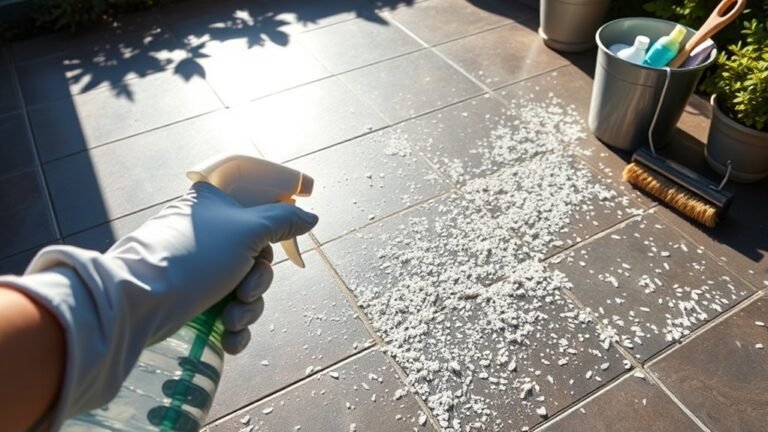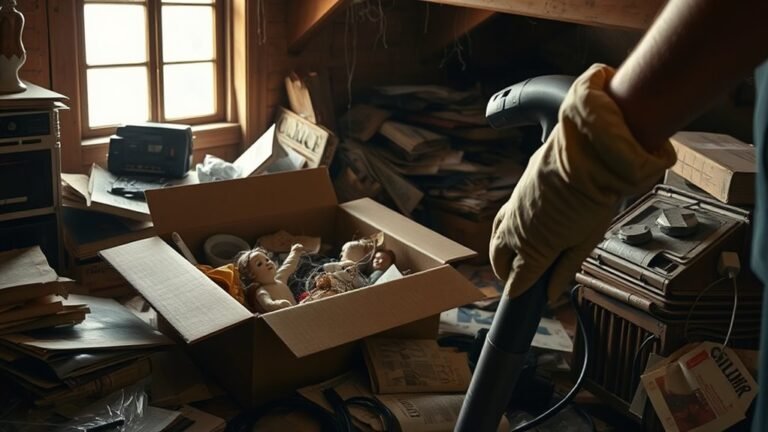Spring Cleaning Guide for Walls
To spring clean your walls, start by dusting off cobwebs with a dry cloth or vacuum. Next, choose a cleaning solution that suits your wall type—mild soap for painted walls or vinegar for wood paneling. Tackle stains gently using a damp cloth or baking soda paste, testing first in a hidden area. Don’t forget to care for wallpaper carefully with minimal moisture. By following these simple tips, you’ll keep your walls fresh and inviting all season. There’s more to learn about making your walls truly shine.
Preparing Your Walls for Cleaning
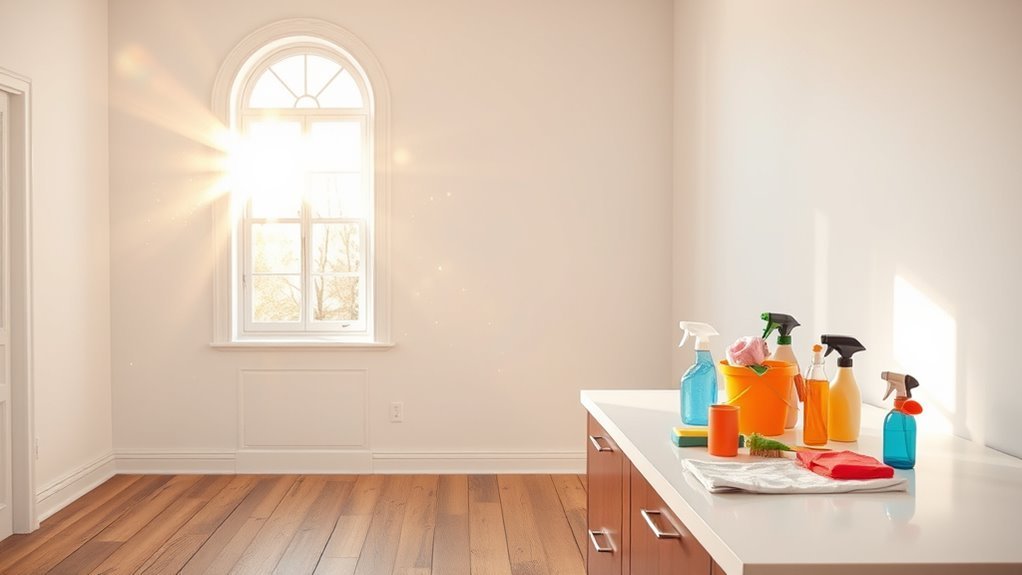
Before you start cleaning, make sure your walls are free of dust and cobwebs by gently wiping them down with a dry cloth or using a vacuum with a brush attachment. This simple step helps you assess the wall condition accurately and prevents dirt from smearing during cleaning. Next, gather all your cleaning supplies, ensuring they’re suitable for your wall type and won’t damage the surface. Check for any cracks, peeling paint, or stains that might need special attention before you proceed. Preparing your walls properly not only makes the cleaning process more effective but also gives you the freedom to tackle it confidently. Taking these initial steps sets a solid foundation for a fresh, vibrant space without unnecessary hassle.
Best Cleaning Solutions for Different Wall Types
When choosing a cleaning solution, it’s important to match it to your wall type to avoid damage and achieve the best results. You want freedom from harsh chemicals and costly products, so consider these eco friendly solutions and DIY cleaners tailored to your walls:
- Painted Walls: Use a mild mix of dish soap and water. This gentle DIY cleaner removes dirt without stripping paint.
- Wallpaper: Avoid excess moisture. A dry microfiber cloth or a vinegar-water spray works wonders without damage.
- Wood Paneling: Mix equal parts vinegar and olive oil for a natural cleaner that cleans and conditions.
- Drywall: Opt for a diluted baking soda paste; it’s tough on grime but safe on porous surfaces.
Choosing the right solution empowers you to clean effectively while protecting your home’s character.
Techniques for Removing Stains and Scuff Marks
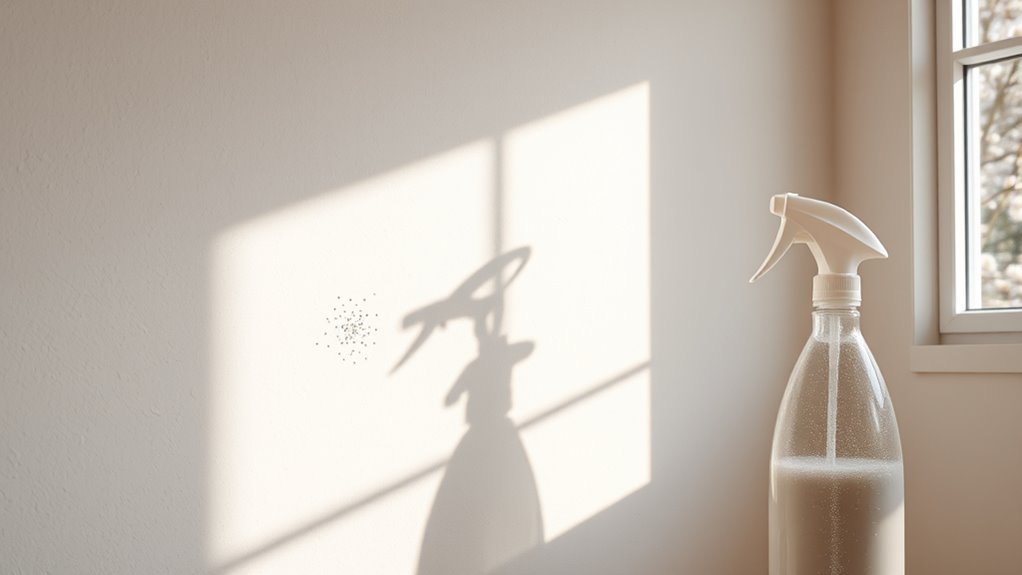
Removing stains and scuff marks from your walls doesn’t have to be a hassle. Start by gently wiping the area with a damp cloth to see if the mark lifts easily. For tougher scuff marks, try a magic eraser or a mixture of baking soda and water—apply gently to avoid damaging paint. When it comes to stain removal, a mild detergent solution often does the trick. Dab the stain carefully and avoid rubbing harshly, which can spread it or harm your wall’s finish. Always test your chosen method on a small, hidden spot first. With these simple techniques, you regain control over your space, keeping your walls fresh and free from stubborn marks without stress or extra effort.
Caring for Wallpaper and Textured Surfaces
Though wallpaper and textured surfaces add character to your walls, they require special care to stay looking their best. For effective wallpaper maintenance and textured surface care, follow these simple steps to keep your walls fresh without restricting your freedom to enjoy your space.
- Dust regularly with a soft cloth or vacuum using a brush attachment to remove surface dirt gently.
- Spot-clean stains promptly using a damp sponge and mild detergent, avoiding harsh chemicals that can damage textures or patterns.
- Test any cleaning solution on a small, hidden area first to verify it doesn’t cause discoloration or peeling.
- Avoid excessive moisture; textured surfaces can trap water, leading to mold or damage.
With these tips, you can maintain your walls’ unique charm while embracing your freedom to live boldly.
Preventative Tips to Keep Walls Looking Fresh Longer
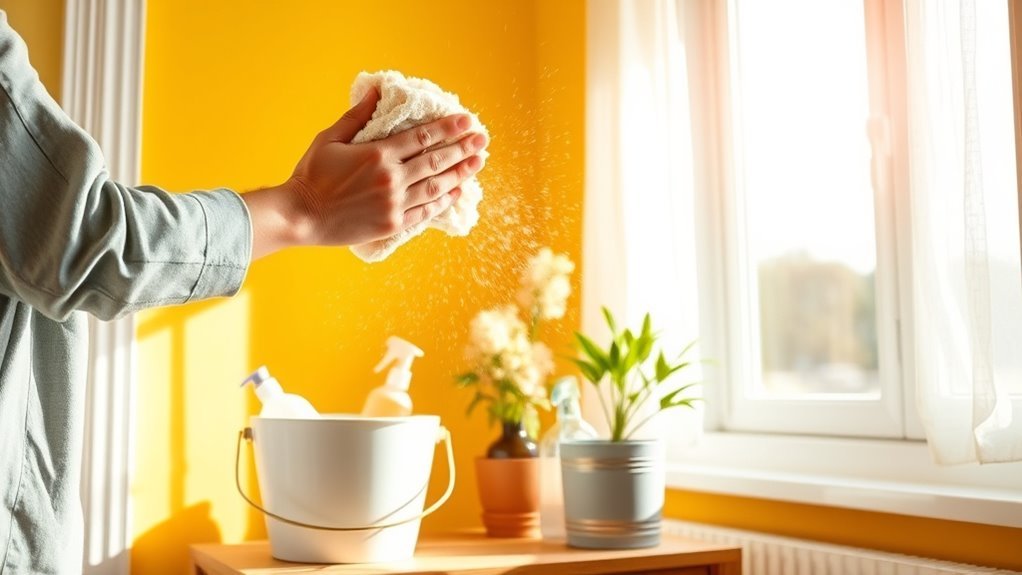
Taking care of wallpaper and textured surfaces helps preserve their beauty, but preventing dirt and damage in the first place can make your cleaning routine much easier. To keep your walls looking fresh longer, focus on regular wall maintenance like dusting with a microfiber cloth to avoid buildup. Avoid harsh chemicals that can wear down paint preservation efforts; instead, use gentle cleaners suited for your wall type. Control humidity levels in your home to prevent mold and peeling, which helps protect both paint and wallpaper. Also, consider placing furniture a few inches away from walls to reduce scuffs and dents. By adopting these simple habits, you’ll enjoy walls that stay vibrant and damage-free, giving you the freedom to focus on what truly matters without constant touch-ups.
Frequently Asked Questions
How Often Should I Schedule a Deep Wall Cleaning Annually?
You might feel torn between wanting your space fresh and not wanting to spend all day cleaning. For wall maintenance, a biannual cleaning usually strikes the perfect balance. Twice a year, you can keep grime and marks at bay without feeling trapped in endless chores. This schedule lets you enjoy a cleaner home while still having the freedom to focus on what matters most to you.
Can Wall Cleaning Improve Indoor Air Quality?
Absolutely, cleaning your walls can help improve indoor air quality by removing dust, mold, and other airborne pollutants that tend to settle there. When you clear away these particles, you reduce what you’re breathing in, leading to noticeable health benefits like fewer allergies and better respiratory comfort. Keeping your walls fresh gives you the freedom to enjoy your space without worrying about hidden irritants impacting your wellbeing.
Are There Eco-Friendly Wall Cleaning Products Recommended?
You might think eco-friendly wall cleaning products won’t be as effective, but you’d be pleasantly surprised. Natural cleaners like vinegar, baking soda, and lemon juice make powerful DIY solutions that’ll refresh your walls without harsh chemicals. Using these, you maintain your freedom to choose safer, greener options while protecting your home’s air quality. Plus, they’re gentle on surfaces and budget-friendly, giving you peace of mind and a cleaner space naturally.
What Tools Are Essential for Safe Wall Cleaning?
When you’re tackling wall cleaning, having the right tools makes all the difference. You’ll want soft sponges or microfiber cloths to protect different wall materials—like drywall, wood, or painted surfaces. A gentle scrub brush can help with stubborn spots without damaging finishes. Don’t forget a bucket with warm water mixed with eco-friendly cleaners. Using these tools along with proper cleaning techniques lets you clean freely and safely, preserving your walls’ look and feel.
How to Handle Mold Growth on Walls During Cleaning?
When you spot mold growth on your walls, don’t panic. Start by wearing gloves and a mask to protect yourself. Use a mix of water and vinegar or a mild bleach solution to scrub the area gently. After cleaning, make sure the walls dry completely to prevent mold recurrence. Good ventilation is key for mold prevention, so keep windows open or use fans. These cleaning techniques help you reclaim your space without hassle.



